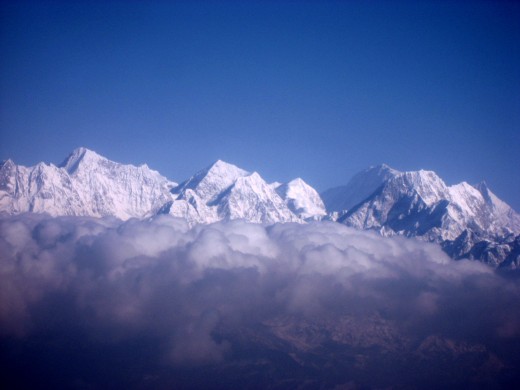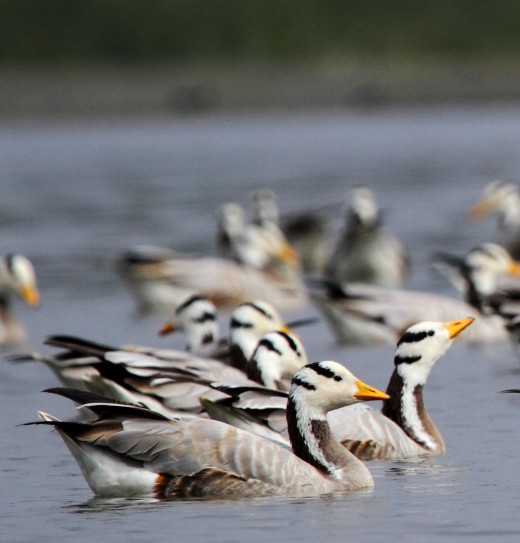Fabulous Facts About the Himalayas
The Himalayas

The Himalayas: Home of the Gods
Often referred to as 'the home of the gods', in Sanskrit the Himalayas translate as 'the abode of snow' - hima, meaning snow, and alaya, meaning dwelling. The chain stretches 2400 kilometers running through five countries, from Pakistan to Bhutan, with Nepal, Tibet and India in between.
Nine out of ten of the world's highest peaks, including Mount Everest, the highest of all, can be found in the range. They are increasing in height due to tectonic shift as the north moving Indian-Australian plate continues to collide with the Eurasion plate at a rate of 5mm per year.
After the polar regions the Himalayas contain the lion's share of ice and snow on Earth. Contrary to scientists' previous predictions, satellite observation has revealed that the region has retained its deposits rather than it melting under the increased temperatures caused by global warming.
Around 1.4 billion people are dependent on water flowing from the rivers of the Himalayas and Tibetan plateau and the monsoons that the Himalayas create.1
Spectacular Views of the Himalayas From 20,000 Feet
The Dangers of Climbing Mount Everest
Probably the first thing people in the west think of when considering the Himalayas is Mount Everest, and that generally means mountaineering.
However anyone considering the ascent of Mount Everest should heed the morbid facts. Roughly ten percent of mountaineers die attempting to climb Everest, an alarming statistic for any intrepid adventurer wanting to conquer the top of the world. More are injured on the way - up and down.
The dangers are manyfold and often weather-related. Good visibility can change on a dime. White-outs are common. Hurricanes blast and batter mountaineers. The severe cold can be a killer. For temperatures to descend to -60 degrees is not uncommon although the lowest recorded is -83 degrees and it never rises above -18, the same as in your freezer. Frostbite is common and you can easily freeze to death. Tents are not unknown to blow away.
The sheer height of Everest - 29,029 feet - means oxygen becomes scarce, just over 60% of that at sea level. Base camp alone is 5200 meters above sea level and a would-be climber is required to produce a certificate to prove they have climbed a minimum of 8000 meters. The section above 8000 meters on Everest is grimly referred to as the death zone. A climber may easily succumb to altitude sickness, high altitude pulmonary edema, or high altitude cerebral edema. Needless to say all these disorders can reach the point of no return for an affected climber.
The Himalayas are unstable. Rockfalls are frequent, crushing climbers in their path. Falling climbers themselves have caused fatalities among others who happen to be in their path. Avalanches, which can be triggered by climbers themselves, earthquakes, or a particular and deadly dynamic of new snow falling on old have buried countless climbers. In 2014, sixteen Nepalese guides were killed by an ice avalanche.2
Crevices are plentiful and difficult to detect. They are extremely unpredictable, opening up and closing without warning, wide or narrow, relatively shallow or unimaginably deep. But once a climber falls foul of one it is a very lucky individual indeed who makes it out. Most do not. No wonder it took until 1953 for the world's highest mountain to be scaled.
Icefall Avalanche on Everest
Around 4000 people have successfully made the ascent of Mount Everest all the way to the summit. Some have even repeated the experience!
Disabled People Have Scaled Everest
At least seven disabled mountaineers have so far climbed Mount Everest, five men and two women.
Being a double amputee was no barrier to New Zealander Mark Inglis achieving his dream of reaching the summit of the world's tallest mountain. An experienced climber, he had lost both legs to frostbite and at the age of 47 made it to the top of the planet.3
The loss of a limb didn't deter two other amputees from realising their dreams either. Paul Hockey has only his left arm, having had his right one removed due to cancer, while Arunima Sinha has only one leg. Both made it to the summit.
Recently the Nepal authorities have banned double amputees and the visually impaired from climbing the Everest, ostensibly to limit the number of deaths.
Mark Inglis

The under 16s are also disbarred from climbing Everest from the Nepalise side. However, Everest can be approached from Tibet, which is exactly how one intrepid Indian girl worked around the restriction. In 2014 Malavath Poorna, aged 13 year and 11 months, "shed joyful tears" when she reached the summit on May 25, becoming the youngest person ever to do so.
Malavath Poorna's Everest Climb
Edmund Hillary As You Wouldn't Believe!
Edmund Hillary and Tenzing Norgay were the first people to have reached the summit of the highest mountain in the world, Everest, on 29 May 1953.
So you'd think Hillary would ask his trusted Sherpa to take a photo of him standing there. Not so. Such was the modest nature of Edmund Hillary, it was he who snapped Sherpa Tenzing waving the British, Nepalese, UN and Indian flags along with a few photographs of different views round and about. He didn't think to ask Tenzing to take a photo of him to mark the event.
They spent about fifteen minutes there during which time Hillary had a pee and buried a few of his daughter's pencils. Tenzing buried some biscuits and sweets as an offering to the gods as traditional in his Buddhist religion. They then began the long descent back to base camp as their oxygen supplies were limited.
Neither of them had realised the impact this lofty achievement was to have. In fact the news was catapulted around the world.
And later on, if you wanted to have a word with Sir Edmund Hillary, as he became later on that year, you could simply look him up in the telephone directory in New Zealand.4
A View From The World's Most Famous Summit
"A symmetrical beautiful snow cone summit" is how Sir Edmund Hillary described the view from Everest which he climbed with Sherpa Tenzing in 1953.
Sir Edmund Hillary and Tenzing Norgay

Too Sacred to Climb
Reverence for Kailash, one of the mountains in northern Tibet, has protected it from climbers clambering all over it. Buddhists, Hindus and people following the Bon religion (the pre-Buddhist shamanistic religion) all respect Kailish. So sacred is it, no-one is allowed to set foot on its revered slopes and it remains pristine. It is believed Lord Shiva lives on the mountain.5
Permits to climb it have never been issued. Personally I think this is a wonderful thing - a rare case of man self regulating and preserving a habitat under the umbrella of holy status.
Mount Kailash, Tibet

High as 19700 feet may seem, the most permanently elevated animal on the planet, isn't a mammal or even a bird, but a spider. At 22,000 feet the Himalayan jumping spider lives an opportunistic life preying on stray insects blown up on the wind.
Himalayas: The Cradle of Flowering Plants
It's not only the animal kingdom that is under threat in the Himalayas. Plant life has also suffered from over-exploitation and some are so finely adapted to the terrain that they cannot live anywhere else. The world renowned Kew Gardens stores seeds from Himalayan plants at their seed bank at Wakeham. The Eastern Himalayas is known as 'the cradle of flowering plants'. Of the 18-21000 species of plants growing in the Himalayas, some 6000 are used in herbal remedies by indigenous people.
You might not associate the Himalayas with tropical rain and deciduous forests but they may be found in the foothills of this unique range. As you climb up, the flora changes, through temperate and alpine forests, alpine meadows up to scrubland before giving out to pure snow covered rock. Sadly deforestation is occurring on an unsustainable scale. Much of the native forest is harvested for firewood and results in devastating floods in the plains of the Ganges and Brahmaputra.
The highest discovered vascular plant is the cushion plant, growing at 6150 meters on India's Mount Shukule II. The oldest were two decade old, as verified by the growth rings in the roots, merely 1mm in diameter. Antifreeze and the rosette style of leaves which can envelop warmer air guard against the acutely cold climate. Moss and algae can tolerate an even higher elevation.6
Both deadly and beautiful, the Himalayas are truly an undisputed wonder of the world. We must hope man does not spoil this wonderful earthly gift to humanity.
The Himalayan Jumping Spider
Alpine meadow at about 3500 m. Khaliya, Munsiari, Uttarakhand

The Highest Living Cat
There are more animal species in the Himalayas than anywhere else in the world.
Probably the most celebrated is the highest living cat - the enigmatic snow leopard. On the vunerable list according to the IUCN Red List of Threatened Species and rarely sighted, this largely solitary cat's territory is vast. It can cover 80 square miles up to a height of 19,700 feet. Thick fur, as with all animals on these peaks, is a buffer against the extreme cold. Large wide paws covered in fur on the underside provide sure-footedness and the ability to pad easily across deep snow.7
The Beautiful Snow Leopard

The Bar-Headed Goose
If you look skywards in the Himalayas, you might be lucky enough to spot the bar-headed goose, distinguished by the two black bands around its head, migrating across the low pressure skies. They are well adapted to the lack of oxygen. Their blood is packed with red blood cells and a large lung capacity to cope with the thin atmosphere.
Unverified sightings claim these geese have flown over Mount Everest, but they have certainly been spotted winging their way round the world's fifth highest peak, Mount Makalu, and tagged specimens have confirmed they are capable of reaching 32,382 feet from the recorded data. And in these rarified conditions they are able to fly a thousand miles in a single day.8
Striking Bar-Headed Geese

The Fabulous Red Panda
Further down the slopes enjoying the coniferous and deciduous forests of the eastern Himalayas is the red panda. Although it's head is a similar shape to the more familiar black and white panda, its body is more like that of a cat and it has a splendid long bushy tail which is why it's also known as red fox.
The giant panda also lives in the less harsh environment of the lower Himalayas and both are classed as endangered. Although it is known for eating bamboo, it will eat other grasses and tubers and even meat occasionally.9

The highest discovered vascular plant is the cushion plant, growing at 6150 meters on India's Mount Shukule II. The oldest were two decade old, as verified by the growth rings in the roots, merely 1mm in diameter. Antifreeze and the rosette style of leaves which can envelop warmer air guard against the acutely cold climate. Moss and algae can tolerate an even higher elevation.
Citations
1 Wikipedia
2 MountEverest.net
3 The Guardian
4 BBC Great Lives
5 Sacred Sites
6 Britannica
7 BBC Nature
8 Birds of Himalaya
9 Wikipedia
© 2018 Frances Metcalfe








